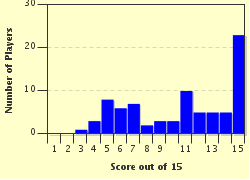Quiz Answer Key and Fun Facts
1. The lead character and pilot of the submersible craft in the undersea adventure 'Stingray' went by which name?
2. What was the name of the airborne 'SPECTRUM' control centre in the 1960s British animated television show 'Captain Scarlet?
3. Which German knight was the arch-enemy of medieval hero 'Sir Prancelot' in the 1970s BBC animation of the same name?
4. The name of the machine that endowed secret agent 'Joe 90' with his special, but temporary powers, was called 'Top Cat'?
5. "I'm a very friendly _____ called Parsley
And I'm always very glad to see you wave
But please don't speak or shout at me too harshly
Because I'm not particularly brave"
The words to the song that was sung by the lead character in the British animated children's show, 'The Herbs'. Which large African feline was played the character, Parsley?
6. In the puppet show 'Hector's House', what kind of creature was Kiki, neighbour to Hector and his, somewhat attractive, pussycat wife ZsaZsa?
7. What was unusual about the early 1970s BBC cut-out animation series 'Crystal Tipps and Alistair'?
8. During the opening titles of the BBC show 'Camberwick Green' the characters appearing in each episode would appear from the inside of which rotating child's toy or adult novelty?
9. 'And, as if by magic, the shopkeeper appeared'... The title for this quiz has been taken from the animated series 'Mr. Benn'. Is that statement true or false?
10. In which type of building did the animated characters Mary, Mungo and Midge live?
11. Giving its name to a trilogy of programmes known as the 'Trumptonshire Trilogy', the BBC stop-frame children's animation show 'Trumpton' was the last of the programmes that made up the trilogy?
12. Which popular British comedy actor, famous for his role in the 1970s 'Green' comedy 'The Good Life', narrated the BBC cartoon series 'Roobarb and Custard'?
13. Crime-fighting hero 'Dangermouse' and his assistant Penfold, defend the world against the evil arch-criminal Baron Greenback. What sort of creature did Baron Greenback keep as a pet?
14. Owned by Lord Belborough, the rich landowner and central character who lived in Winkstead Hall, Chigley, 'Bessie' and 'Binnie' were characterised as what exactly?
15. Before his death in 2008, who was the hugely popular creator, writer and producer of the beloved television animations 'The Clangers', 'Mr Benn', 'Bagpuss' and 'Pogles Wood' amongst many others?
Source: Author
SisterSeagull
This quiz was reviewed by FunTrivia editor
kyleisalive before going online.
Any errors found in FunTrivia content are routinely corrected through our feedback system.

